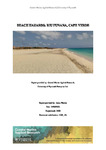Beach Hazards: Riu Funana, Cape Verde v3b.
| dc.contributor.author | Stokes, C | |
| dc.contributor.author | Masselink, Gerd | |
| dc.contributor.author | Brodie, L | |
| dc.date.accessioned | 2022-05-25T14:35:45Z | |
| dc.date.available | 2022-05-25T14:35:45Z | |
| dc.date.issued | 2022-05-25 | |
| dc.identifier.other | 2109_v3b | |
| dc.identifier.uri | http://hdl.handle.net/10026.1/19265 | |
| dc.description.abstract |
Coastal Marine Applied Research (CMAR) have been commissioned by Adam Wooler to assess physical bathing hazards at Clubhotel Riu Funana in the Santa Maria resort, Sal, Cape Verde. A bathing injury has occurred at the beach adjacent to the Clubhotel Riu Funana, and this report seeks to estimate the wave and beach morphology conditions at the time of the bathing incident, as well as to identify typical bathing conditions that occur throughout the year at the beach. Through a process of expert judgement using a combination of wave analysis, and assessment of in-situ and satellite imagery, the beach at Riu Funana beach is expected to sit within the ‘reflective’ or ‘low tide terrace’ end of the beach morphology spectrum. The likely beach profile gradient in the area of wave breaking is expected to be 0.1 (slope of 1-in-10), which represents a steep beach profile. Steep beaches exposed to small wave heights with long wavelengths experience plunging or collapsing/surging wave breakers. Such waves break intensely across a narrow region of beach, with collapsing/surging waves breaking right at the shoreline. Given the expected beach morphology and wave breaker types, shore-break impact injuries are expected to be the primary beach hazard type at Riu Funana beach. From processed wave model data, maximum breaking wave heights (defined here as the largest individual wave occurring in a given period of time) at the site are predicted to vary between 0.5 and 7.0 m, but only exceed 2.3 m 10% of the time. Wave breaking is predicted to be predominantly within the ‘plunging’ regime, but periods characterised by ‘collapsing’ and ‘surging’ breakers are also evident. These represent the most powerful of the wave breaker types. In-situ photographs of waves breaking at Clubhotel Riu Funana confirm that waves typically break very close to the beach, and even the larger waves (breaking wave height, Hb > 1 m) break as plunging breakers with considerable breaking intensity and power at the shoreline. On the day of the bathing incident on the 31st March 2018, wave heights are predicted to have been similar to the annual-average significant breaking wave height but lower than the seasonal-average breaking wave height for the season in which the incident occurred (winter). Accounting for uncertainties in the wave conditions and beach slope, there is 95% confidence that the breaker type was plunging, collapsing, or surging around the time of the incident, with the largest individual wave around the time of the incident (estimated to be approximately 1.3 m in height) predicted to have been either plunging or collapsing as it broke. The combination of wave height and period at the time of the bathing incident sits within a transitional range representing the overlap between wave conditions typically associated with yellow flags and those associated with red flags flown at the beach during March and April of 2018. | |
| dc.language.iso | en | |
| dc.rights | Attribution-ShareAlike 4.0 International | |
| dc.rights.uri | http://creativecommons.org/licenses/by-sa/4.0/ | |
| dc.title | Beach Hazards: Riu Funana, Cape Verde v3b. | |
| dc.type | report | |
| plymouth.confidential | false | |
| plymouth.organisational-group | /Plymouth | |
| plymouth.organisational-group | /Plymouth/Faculty of Science and Engineering | |
| plymouth.organisational-group | /Plymouth/Faculty of Science and Engineering/School of Biological and Marine Sciences | |
| plymouth.organisational-group | /Plymouth/REF 2021 Researchers by UoA | |
| plymouth.organisational-group | /Plymouth/REF 2021 Researchers by UoA/UoA07 Earth Systems and Environmental Sciences | |
| plymouth.organisational-group | /Plymouth/Users by role | |
| plymouth.organisational-group | /Plymouth/Users by role/Academics | |
| dc.publisher.place | University of Plymouth | |
| dc.rights.embargoperiod | Not known | |
| rioxxterms.licenseref.uri | http://creativecommons.org/licenses/by-sa/4.0/ | |
| rioxxterms.type | Technical Report |



